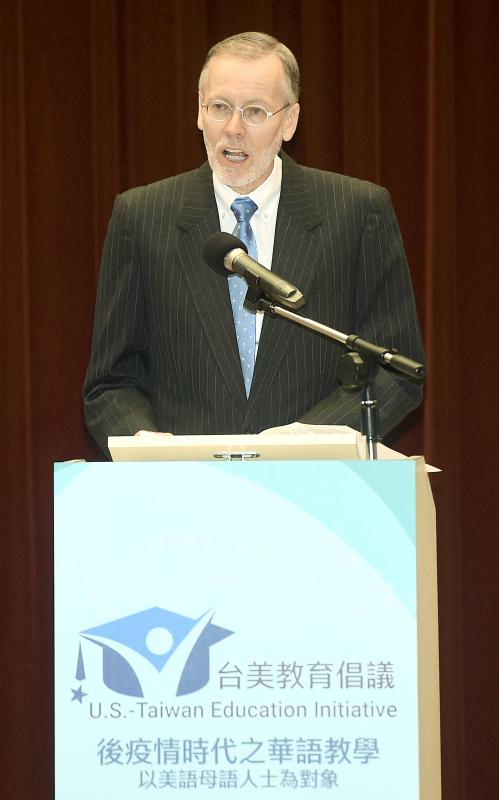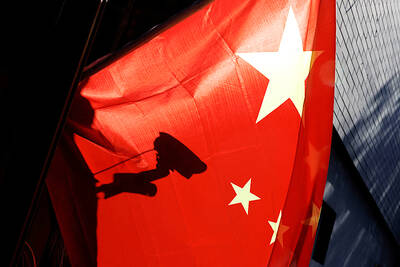With the closure of China’s Confucius Institutes in the US, it is time for Taiwan to fill the Mandarin teaching gap and share “a different version of history” with US students, American Institute in Taiwan (AIT) Director Brent Christensen told the Chinese Language Symposium to Support the US-Taiwan Education Initiative in Taipei yesterday.
“We have all read news stories about the closing of many of the PRC’s [People’s Republic of China] Confucius Institutes in the US. Now is the time for Taiwan to step forward and help fill this gap — not only to teach Mandarin and learn English, but to more fully tell Taiwan’s story to their American students,” Christensen said in Mandarin.
The US Department of State in August last year designated the Confucius Institute US Center as a Chinese “foreign mission” for multifaceted propaganda efforts.

Photo: Chien Jung-fong, Taipei Times
After Taiwan and the US last month signed a memorandum of understanding on international education cooperation, both sides have agreed to expand existing programs, including the Fulbright Foreign Language Teaching Assistant Program, Christensen said.
Wishing good luck to about 60 program participants who are to teach Mandarin in the US, he told them they play a crucial role in teaching young Americans a language spoken by 1.3 billion native speakers around the world and have the opportunity to tell a different version of history than the one taught at Confucius Institutes.
‘CIVIC AMBASSADORS’
Encouraging Taiwanese instructors to serve as “civic ambassadors” and make more friends, National Security Council (NSC) Deputy Secretary-General Hsu Szu-chien (徐斯儉) said the government attaches great importance to the program, and the council since May last year has been coordinating inter-agency efforts to make plans to promote Mandarin teaching in the US and Europe.
Many senior US researchers on Chinese affairs had learned Mandarin in Taiwan during or after China’s Cultural Revolution, Department of North American Affairs Director-General Douglas Hsu (徐佑典) said, but added that when Taipei stopped funding the Stanford Center at National Taiwan University and China opened up to the world late last century, many Americans turned to China to learn the language, which resulted in their alienation from Taiwan’s views when addressing cross-strait issues.
As many prestigious universities in the US, including military academies, are establishing Mandarin-teaching departments, Taiwan should take the opportunity to tout its teaching resources online and offline, he added.
In the US, the number of K-12 students learning Mandarin exceeded 400,000 in 2017, doubling from only two years earlier, AIT Deputy Director Raymond Greene said.
US students traditionally chose Spanish as their second language, but more have been opting for Mandarin, he said.
Over the past few years, students and academics have avoided going to China, first due to environmental and then political concerns, as Beijing imposes more totalitarian restrictions on Internet use and the freedom of speech, he said.
Asked if the trend might shift back to Beijing if US-China relations improve, Greene said it is a natural shift for such people to come to Taiwan, adding that the trend would only continue to grow.

A magnitude 7.0 earthquake struck off Yilan at 11:05pm yesterday, the Central Weather Administration (CWA) said. The epicenter was located at sea, about 32.3km east of Yilan County Hall, at a depth of 72.8km, CWA data showed There were no immediate reports of damage. The intensity of the quake, which gauges the actual effect of a seismic event, measured 4 in Yilan County area on Taiwan’s seven-tier intensity scale, the data showed. It measured 4 in other parts of eastern, northern and central Taiwan as well as Tainan, and 3 in Kaohsiung and Pingtung County, and 2 in Lienchiang and Penghu counties and 1

FOREIGN INTERFERENCE: Beijing would likely intensify public opinion warfare in next year’s local elections to prevent Lai from getting re-elected, the ‘Yomiuri Shimbun’ said Internal documents from a Chinese artificial intelligence (AI) company indicated that China has been using the technology to intervene in foreign elections, including propaganda targeting Taiwan’s local elections next year and presidential elections in 2028, a Japanese newspaper reported yesterday. The Institute of National Security of Vanderbilt University obtained nearly 400 pages of documents from GoLaxy, a company with ties to the Chinese government, and found evidence that it had apparently deployed sophisticated, AI-driven propaganda campaigns in Hong Kong and Taiwan to shape public opinion, the Yomiuri Shimbun reported. GoLaxy provides insights, situation analysis and public opinion-shaping technology by conducting network surveillance

Taiwan is gearing up to celebrate the New Year at events across the country, headlined by the annual countdown and Taipei 101 fireworks display at midnight. Many of the events are to be livesteamed online. See below for lineups and links: Taipei Taipei’s New Year’s Party 2026 is to begin at 7pm and run until 1am, with the theme “Sailing to the Future.” South Korean girl group KARA is headlining the concert at Taipei City Hall Plaza, with additional performances by Amber An (安心亞), Nick Chou (周湯豪), hip-hop trio Nine One One (玖壹壹), Bii (畢書盡), girl group Genblue (幻藍小熊) and more. The festivities are to

Auckland rang in 2026 with a downtown fireworks display launched from New Zealand’s tallest structure, Sky Tower, making it the first major city to greet the new year at a celebration dampened by rain, while crowds in Taipei braved the elements to watch Taipei 101’s display. South Pacific countries are the first to bid farewell to 2025. Clocks struck midnight in Auckland, with a population of 1.7 million, 18 hours before the famous ball was to drop in New York’s Times Square. The five-minute display involved 3,500 fireworks launched from the 240m Sky Tower. Smaller community events were canceled across New Zealand’s